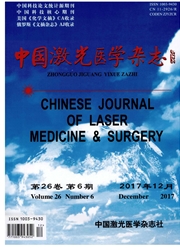

 中文摘要:
中文摘要:
光动力疗法(photodynamic therapy,PDT)是一种联合利用光敏剂、光和氧,通过光动力反应选择性地治疗疾病的靶向疗法。氧作为PDT的关键要素之一,直接决定毒性物质单态氧和其他活性氧的产量,进而影响PDT的疗效。PDT中组织氧的在体和实时监测是一个具有挑战性的技术难题,在过去的20年中,基于不同原理的各种组织氧的测量技术被相继开发和应用。笔者在阐述PDT中氧的作用机制基础上,详细讨论组织氧的直接和间接测量技术,分析各种测量技术的优点和局限性,展望组织氧测量技术在优化PDT治疗方案和评估疗效中的应用,简要评述面临的技术挑战。
 英文摘要:
英文摘要:
Photodynamic therapy(PDT) utilizes jointly photosensitizers,light of appropriate wavelengths and tissue oxygen to selectively destroy target tissues.Being essential to PDT,the availability of molecular oxygen is extremely important for the generation of singlet oxygen and other reactive oxygen species,which directly determines the therapeutic outcomes.Although monitoring tissue oxygen in vivo and in real time is still technically challenging,various sensitive monitoring techniques have been developed during the past two decades.This review summaries existing techniques for measuring tissue oxygen,and the strengths and limitations of each methodology are discussed in detail.In particular,the emerging optical techniques to monitor tissue oxygen on a non-invasive basis are highlighted,which shows great promise for clinical use.Finally,the main challenges and prospect of clinical tissue oxygen monitoring during PDT treatment are analyzed.
 同期刊论文项目
同期刊论文项目
 同项目期刊论文
同项目期刊论文
 Vascular targeted photodynamic therapy for bleeding gastrointestinal mucosal vascular lesions: A pre
Vascular targeted photodynamic therapy for bleeding gastrointestinal mucosal vascular lesions: A pre Assessment of Tissue Perfusion Changes in Port Wine Stains after Vascular Targeted Photodynamic Ther
Assessment of Tissue Perfusion Changes in Port Wine Stains after Vascular Targeted Photodynamic Ther Monitoring Microcirculation Changes in Port Wine Stains During Vascular Targeted Photodynamic Therap
Monitoring Microcirculation Changes in Port Wine Stains During Vascular Targeted Photodynamic Therap Influence of laser power density on damage of comb by photodynamic therapy-simulation and validation
Influence of laser power density on damage of comb by photodynamic therapy-simulation and validation The potential of photodynamic therapy to treat esophageal candidiasis coexisting with esophageal can
The potential of photodynamic therapy to treat esophageal candidiasis coexisting with esophageal can Influence of pulse-height discrimination threshold for photon counting on the accuracy of singlet ox
Influence of pulse-height discrimination threshold for photon counting on the accuracy of singlet ox Twenty Years of Clinical Experience with a New Modality of Vascular-Targeted Photodynamic Therapy fo
Twenty Years of Clinical Experience with a New Modality of Vascular-Targeted Photodynamic Therapy fo Investigation of photodynamic therapy optimization for port wine stain using modulation of photosens
Investigation of photodynamic therapy optimization for port wine stain using modulation of photosens 期刊信息
期刊信息
